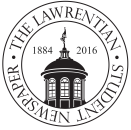On the evening of Wednesday, Oct. 26, Kevin J. Olival, Associate Vice President for Research at EcoHealth Alliance presented a lecture titled “Forecasting and Preventing Viral Zoonoses: Integrating Wildlife Conservation and Public Health Research.” This lecture is the second installation in the Spoerl Lecture Series in Science and Society, which is co-sponsored by the Recent Advances in Biology Lecture Series. Olival took the stage in Room 102 of the Thomas Steitz Hall of Science to shed light on how to predict and prevent viral zoonoses and ecological interface between human and animals.
The Spoerl Lecture Series in Science and Society invites professors and scholars from other universities and institutions and is established by Milwaukee-Downer Class of 1944 alumna Barbara Gray Spoerl and her husband, Edward Spoerl. The Spoerl Series seeks to promote academic discourse on the role of science and technology in global societies.
As an ecologist and evolutionary biologist, Olival has been researching emerging infectious diseases for over a decade. He graduated from Columbia University in 2008 with a Doctorate in ecology and evolutionary biology and a Master of Arts in conservation biology. He also has kept track of large groups of bats in Southeast Asia and has examined the relationship between wildlife conservation and viruses infecting humans and other animals.
Throughout the talk, Olival appealed for the necessity of zoonosis research and its impact on human health. Zoonosis is an infectious disease transmitted from animals to humans. He introduced some notorious examples of zoonosis such as SAS, Ebola, and Zika, which all originated from wildlife populations, rather than from domestic animals. Although exactly how animals transmit the diseases to humans lies at the hand of scientists to unravel, he stressed that wildlife plays a considerable role in propagating the viruses. These potential viruses existing in wildlife may go unnoticed and engender a tremendous threat to human health.
In light of wildlife conservation, he next explained how human activities can spark or spread the zoonotic outbreaks. As human population extends to wild animal habitats, he noted human activities such as agricultural intensification, deforestation and bushmeat hunting may lead to ecological disruption and zoonotic diseases running rampant. He said, “Humans induced changes that are causing these diseases to emerge…Disease emergence is an ecological phenomenon, not an evolutional phenomenon.”
Olival lastly illuminated collaborative research efforts in predicting zoonotic disease emergence. He illustrated how scientists predict the geographical place, or so-called “hotspots,” of the next zoonoses, the most risky host species and even the “missing zoonoses”—the number of potential diseases one can find in an animal. While previously doctors found hard to connect zoonotic outbreaks and wildlife conservation, the EcoHealth Alliance for which Olival works investigates the ecological interface between human health and both domestic and wild animals.
Many students taking environmental studies, along with a few professors, filled the hall. After the lecture, students found the speech both instructive and intriguing. Junior Louis Weissert said, “The most interesting thing about the lecture was the intersection between zoonotic disease [and human health].” Junior Maamie Appiah also agreed, “I am not really into biology…and don’t care about animals. But it was interesting to see the intersection between human health and animals.”

